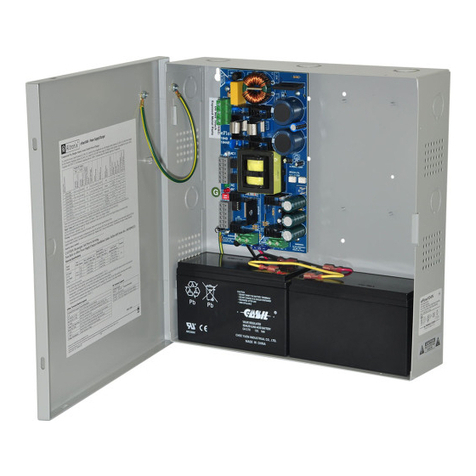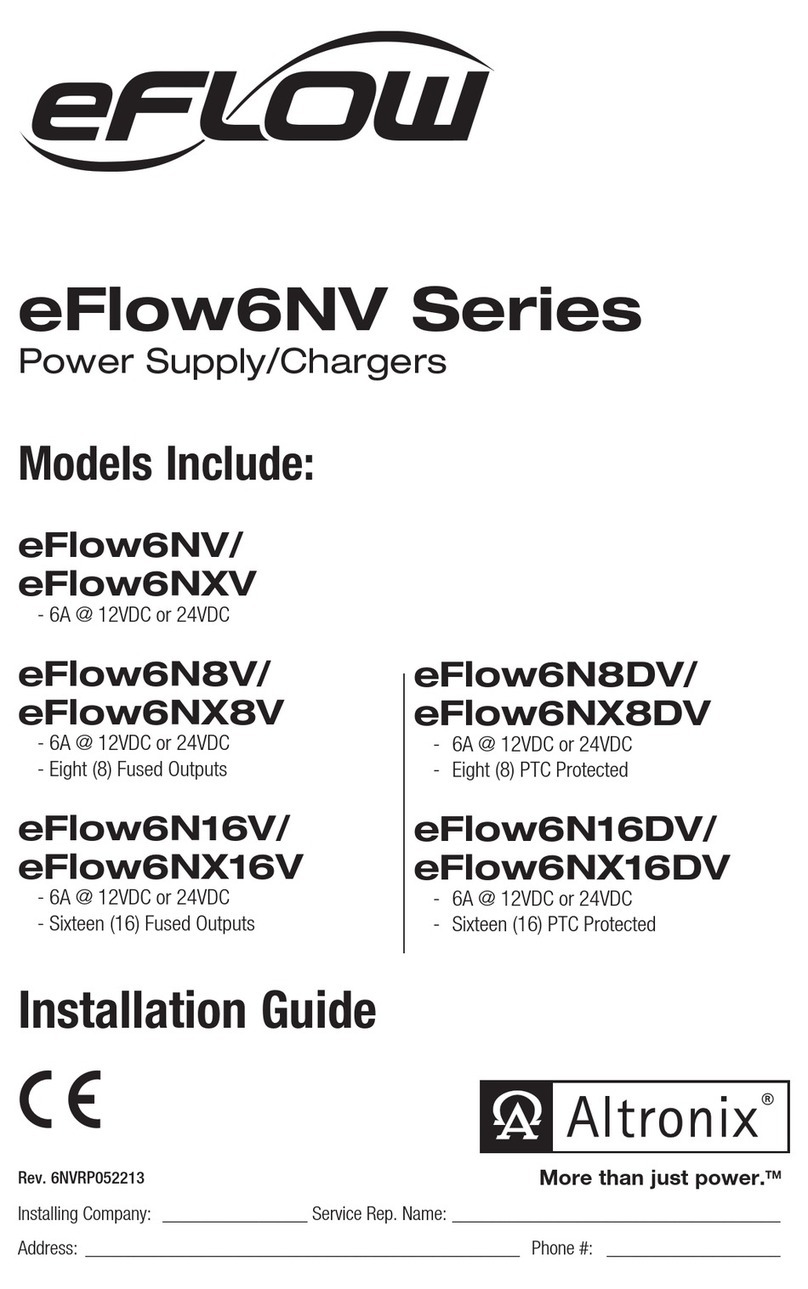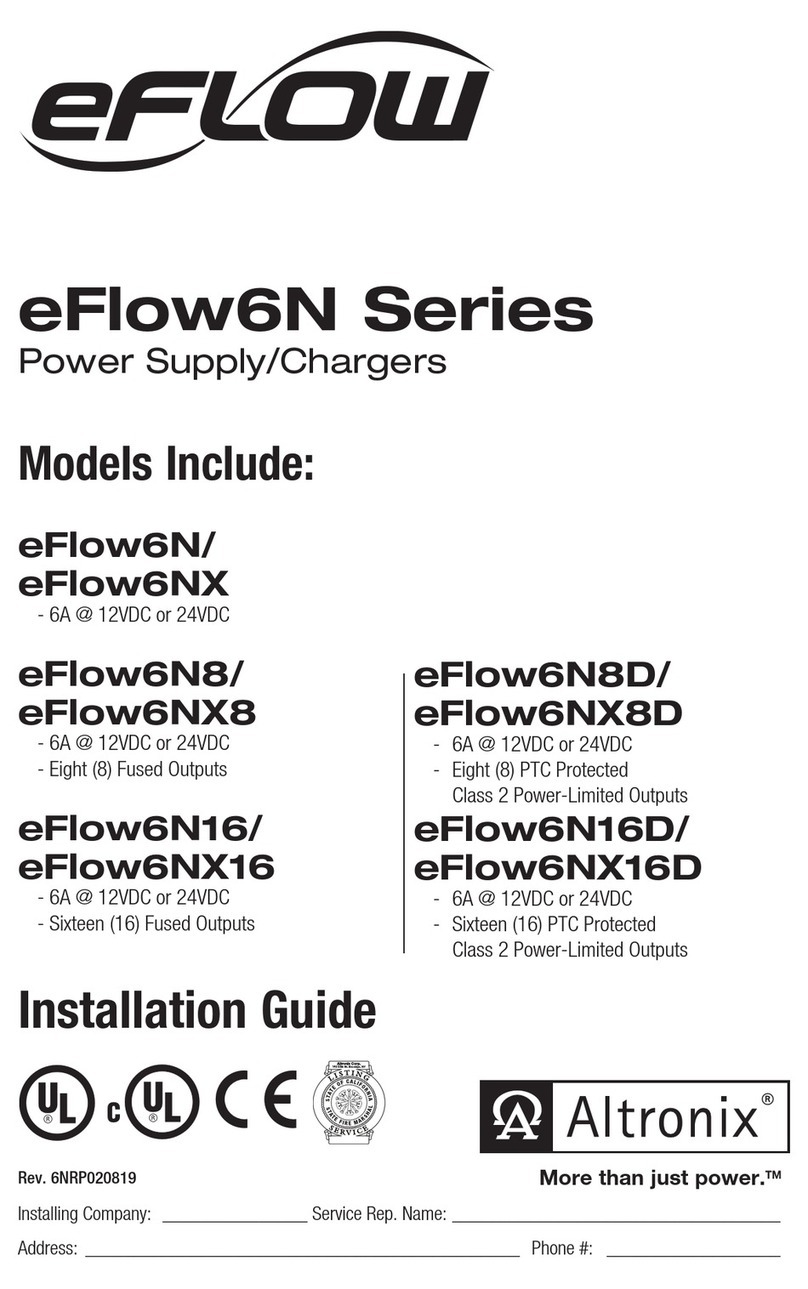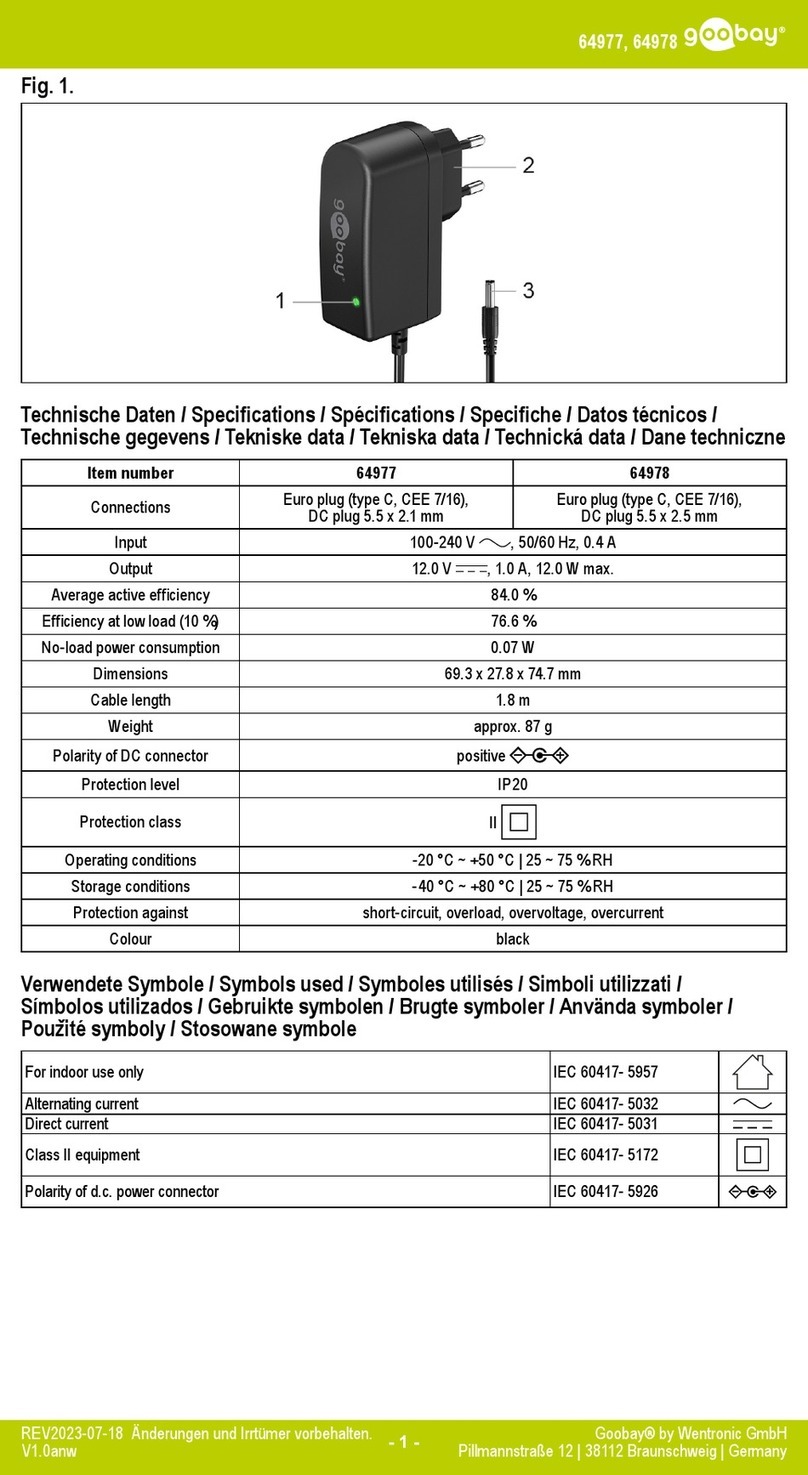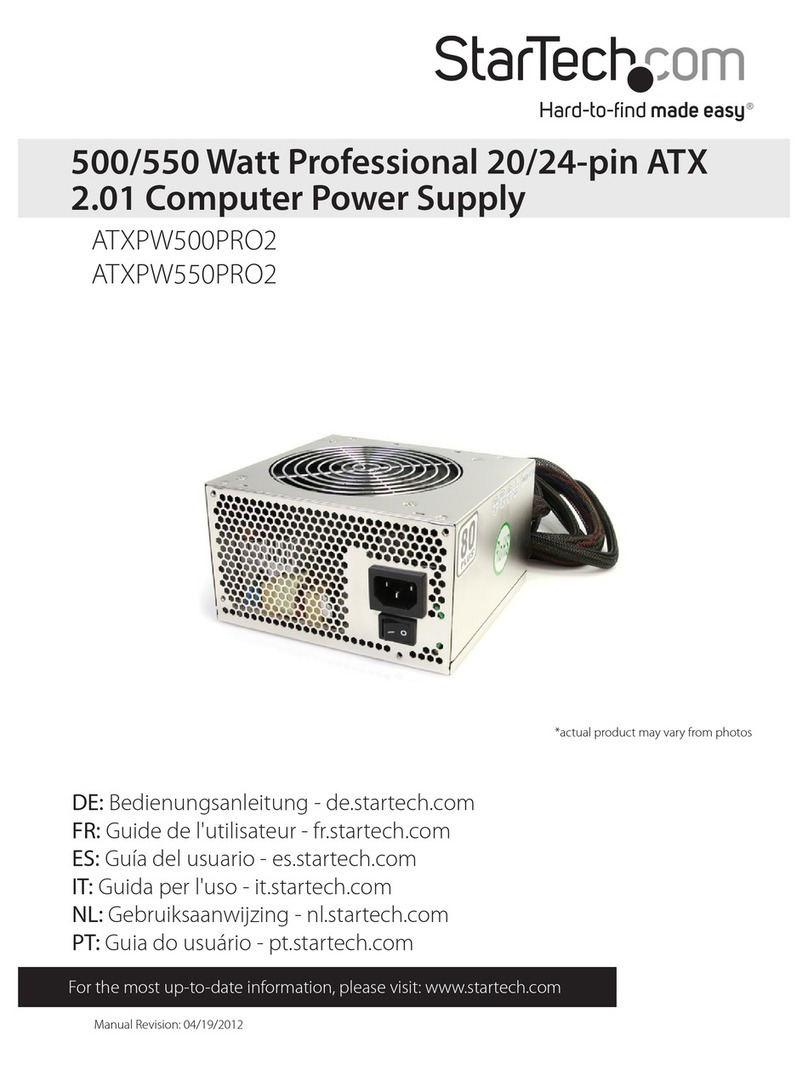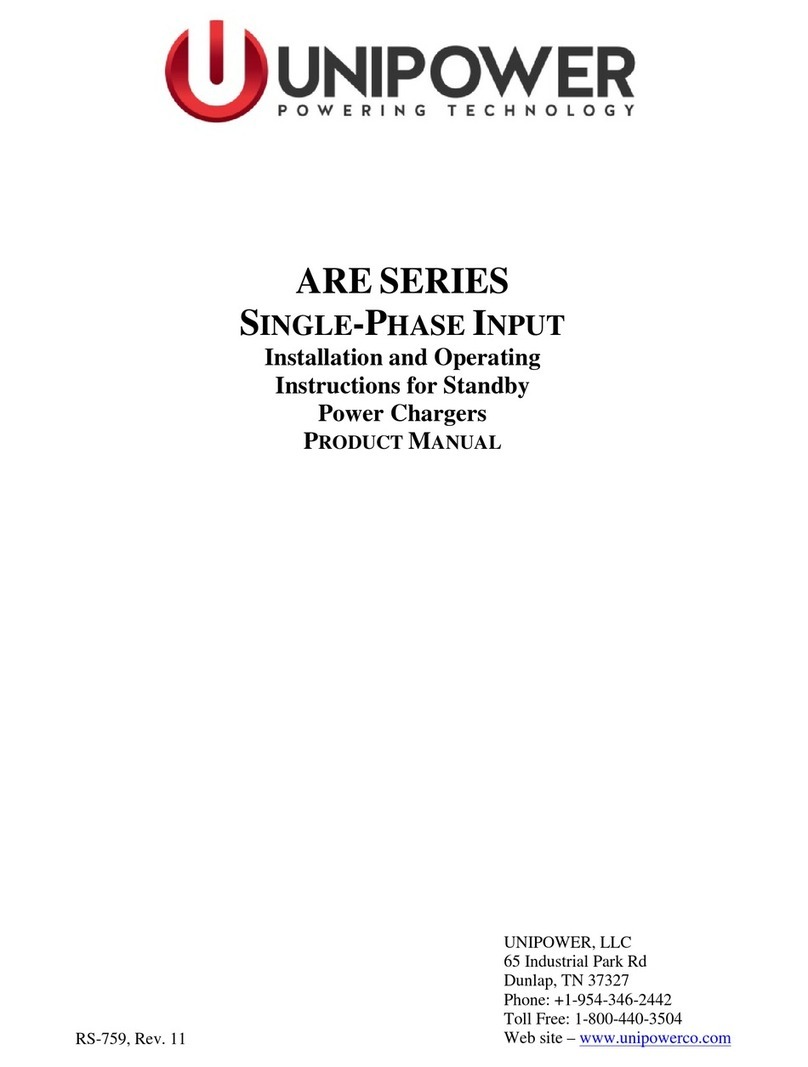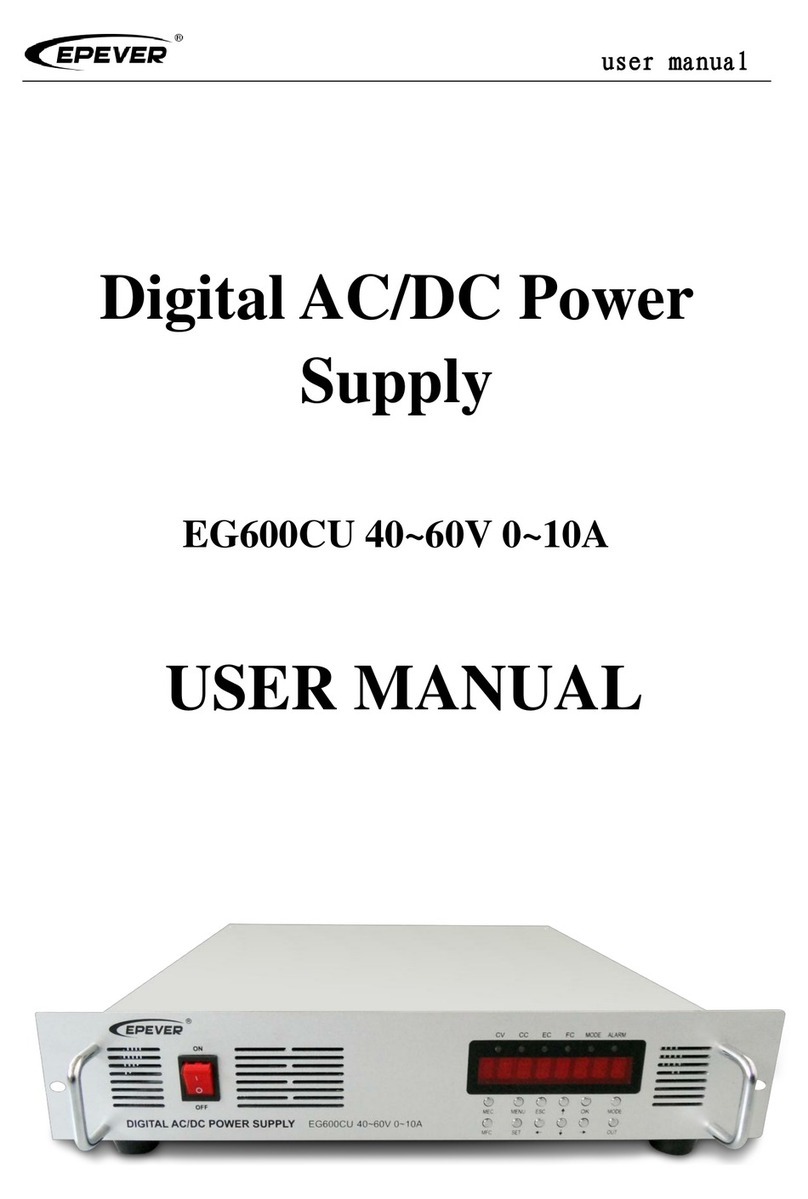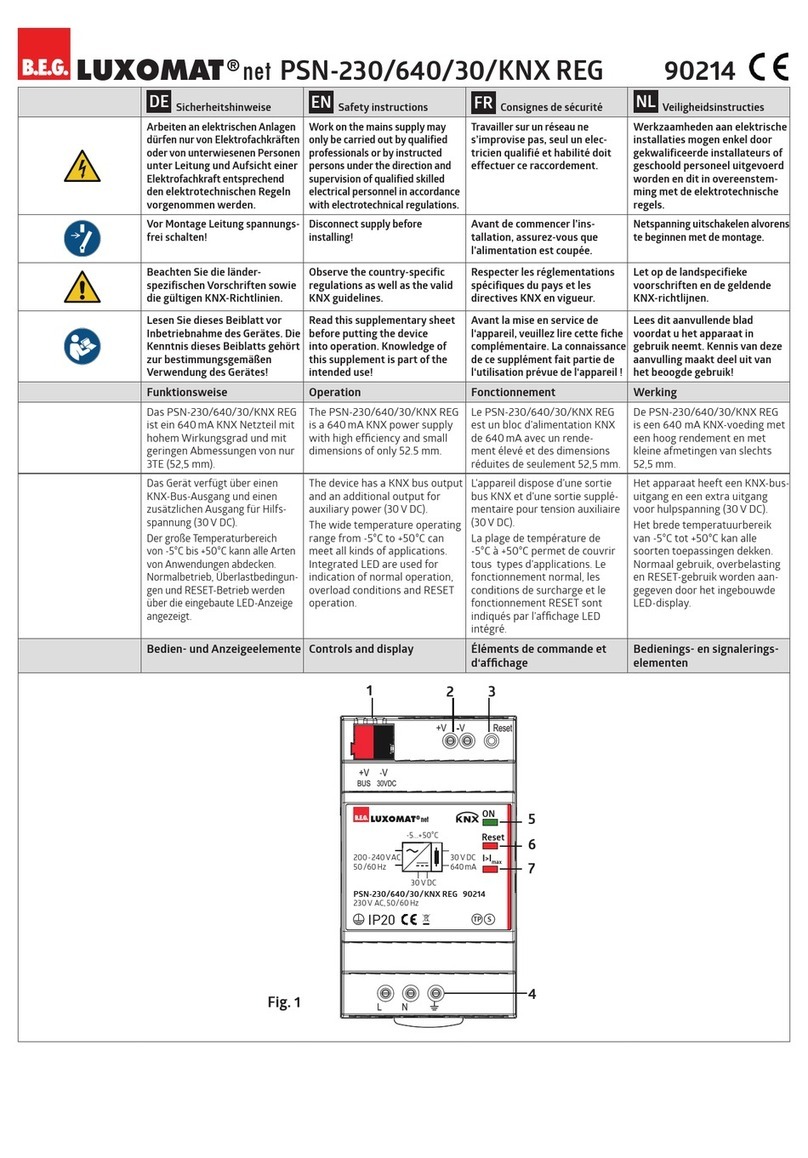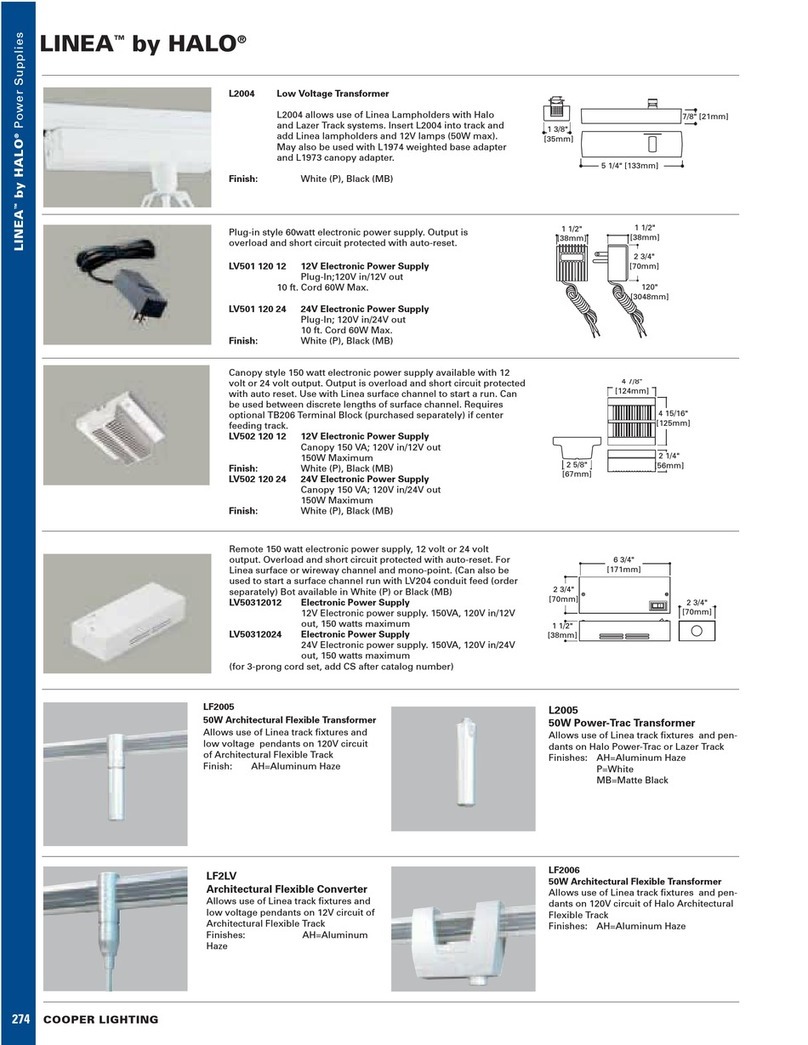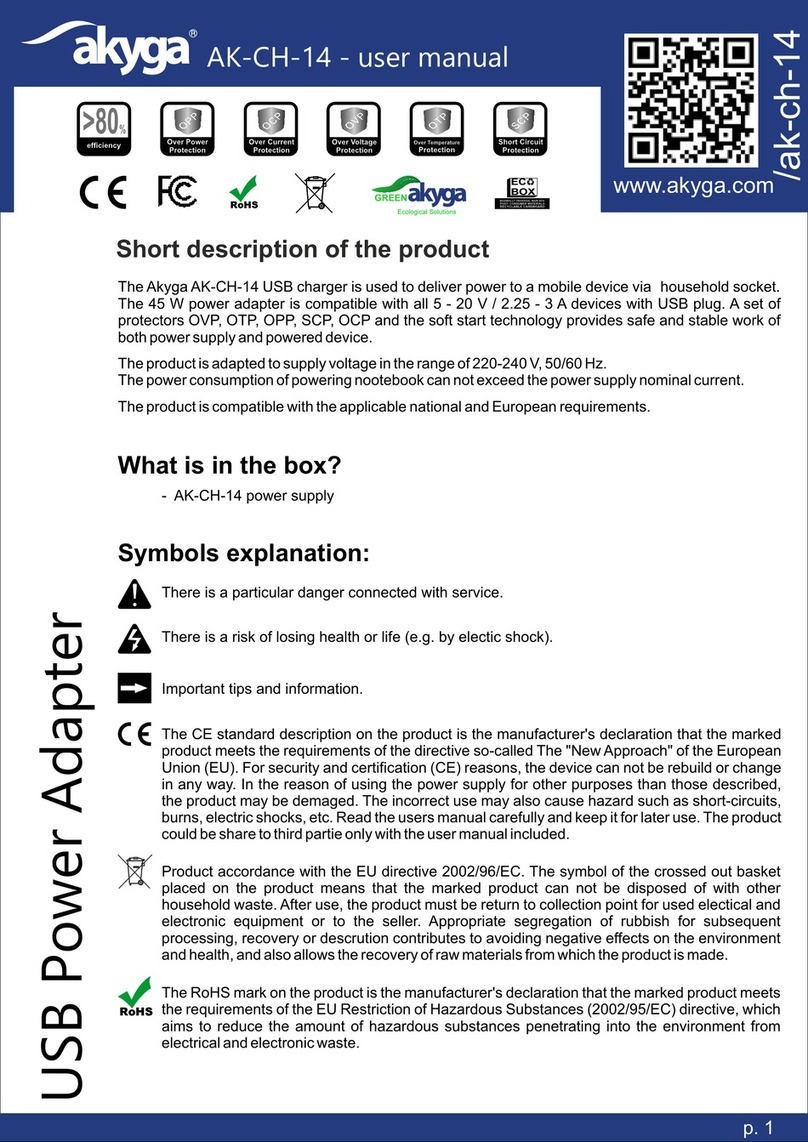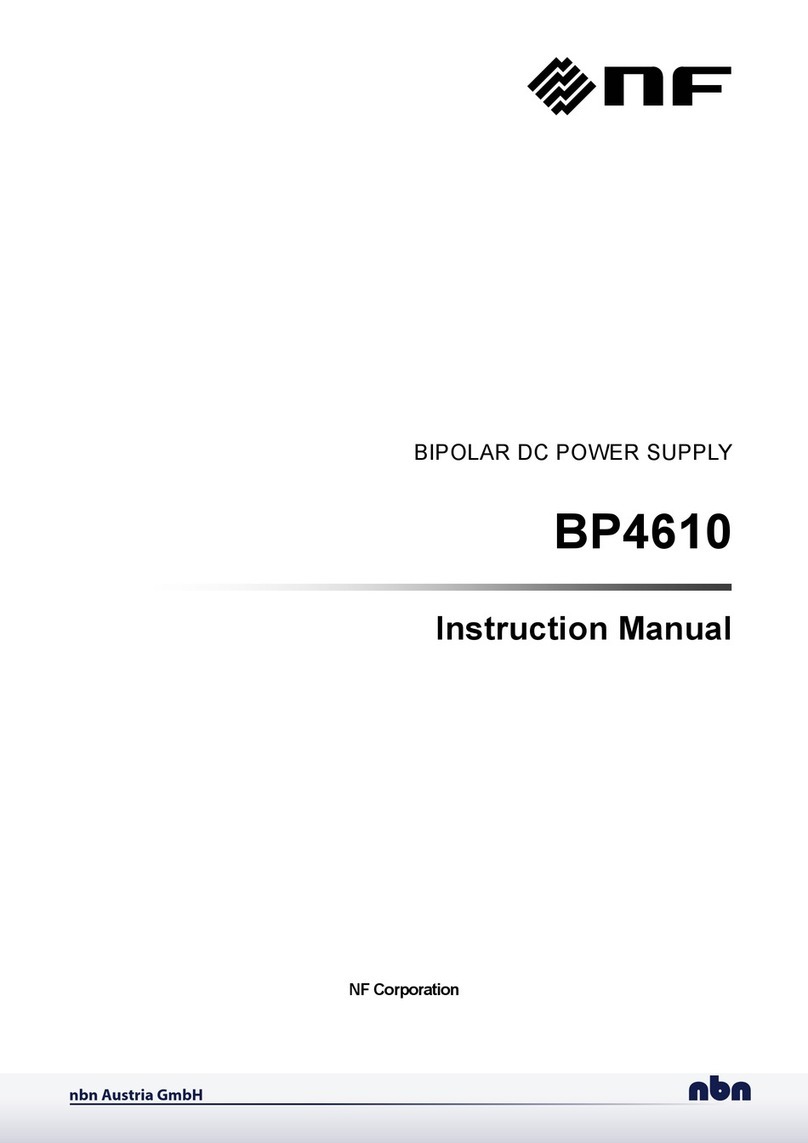EFLOW eFlow3NV User manual

Power Supply/Chargers
Installation Guide
Models Include:
eFlow3NV/eFlow3NXV
- 2A @ 12VDC or 24VDC
eFlow3N4V/eFlow3NX4V eFlow3N4DV/eFlow3NX4DV
- 2A @ 12VDC or 24VDC - 2A @ 12VDC or 24VDC
- Four (4) Fused Outputs - Four (4) PTC Outputs
Rev. 3NVRP122713 More than just power.™
Installing Company: _____________________ Service Rep. Name: __________________________________________
Address: ________________________________________________________ Phone #: _________________________

- 2 - eFlow3NV Series
Overview:
The eFlow3NV power supply/chargers convert a 220VAC (working range 198VAC - 256VAC), 50/60Hz input to a
12VDC or 24VDC nominal output (see Power Supply Configuration Reference Chart and Specifications).
eFlow3NV Series Power Supply Configuration Reference Chart:
Altronix
Model Number
Nominal DC Outputs
Maximum Supply
Current for Main and
Aux. Outputs (A)
Input Rating:
220VAC 50/60Hz
Input Fuse Rating
Battery Fuse Rating
Ripple Voltage (mV)
Under low battery condition
Power Distribution
Modiule
Number of Outputs
Fused Output Ratings
Auto-Resettable
PTC Output Ratings
Accommodates up to
7AH Batteries
Accommodates up to
12AH Batteries
[DC] [AUX]
12VDC Output
Range (V)
24VDC Output
Range (V)
12VDC Output
Range (V)
24VDC Output
Range (V)
eFlow3NV 10.13-
13.2
20.28-
26.39
10.15-
13.2
20.2-
26.39 2A 2.1A 5A/250V 3A/32V 960 N/A 1
– – P–
eFlow3NXV – – – P
eFlow3N4V 10.13-
13.2
20.28-
26.39
10.15-
13.2
20.2-
26.39 2A 2.1A 5A/250V 3A/32V 960 PD4 4
2A – P–
eFlow3NX4V 2A – – P
eFlow3N4DV 9.78-
13.2
20.0-
26.39
10.15-
13.2
20.2-
26.39 2A 2.1A 5A/250V 3A/32V 960 PD4CB 4
– 2A P–
eFlow3NX4DV – 2A – P
These units are suitable to power sensors, electro-mechanical devices (e.g. electric door strikes) defined in the National Electrical Code/
NFPA70/NFPA72 and the Canadian Electrical Code, Part 1.
European Conformity
Stand-by Specifications:
Battery
Burg. Applications
4 hr. Stand-by/
15 min. Alarm
Fire Applications
24 hr. Stand-by/
5 min. Alarm
Access Control
Applications
Stand-by
7AH 0.4A/2A N/A 1.5 Hours/2A
12AH 1A/2A 0.3A/2A 3.5 Hours/2A
40AH (for eFlow3NXV refer to Fig. 7, pg. 10) 2A/2A 1.2A/2A Over 4 Hours/2A
65AH (for eFlow3NXV refer to Fig. 7, pg. 10) 2A/2A 1.5A/2A Over 4 Hours/2A
Specifications:
Input:
• 220VAC (working range 198VAC - 256VAC), 50/60Hz.
Output:
• For output voltage and supply current,
refer to eFlow3NV series Power Supply Configuration
Reference Chart, pg. 2.
• Auxiliary output rated @ 1A (unswitched).
• Overvoltage protection.
Battery Backup:
• Built-in charger for sealed lead acid or gel type batteries.
• Maximum charge current 1.54A.
• Automatic switch over to stand-by battery when AC fails.
Transfer to stand-by battery power is instantaneous with
no interruption.
Fire Alarm Disconnect:
• Supervised Fire Alarm disconnect (latching or non-
latching) 10K EOL resistor. Operates on a normally
open (NO) or normally closed (NC) trigger.
Supervision:
• AC fail supervision (form “C” contacts).
• Battery fail & presence supervision (form “C” contacts).
Supervision (cont’d):
• Low power shutdown. Shuts down DC output terminals
if battery voltage drops below 71-73% for 12V units
and 70-75% for 24V units (depending on the power
supply). Prevents deep battery discharge.
Fuse Ratings:
• Refer to eFlow3NV Series Power Supply Configuration
Reference Chart, pg. 2.
Visual Indicators:
• Green AC Power LED indicates 220VAC present.
• AC input and DC output LED indicators.
Additional Features:
• Short circuit and overload protection.
• Unit is complete with power supply, enclosure,
battery leads and cam lock.
Enclosure Dimensions (approximate H x W x D):
eFlow3NV, eFlow3N4V, eFlow3N4DV:
13.5” x 13” x 3.25” (342.9mm x 330.2mm x 82.55mm)
eFlow3NXV, eFlow3NX4V, eFlow3NX4DV:
15.5” x 12” x 4.5” (393.7mm x 304.8mm x 114.3mm)

eFlow3NV Series - 3 -
Installation Instructions:
Wiring methods should be in accordance with the National Electrical Code/NFPA 70/NFPA 72/ANSI, The Canadian
Electrical Code, Part 1 and with all local codes and authorities having jurisdiction. The product must be located indoors
within the protected premises.
1. Mount unit in the desired location. Mark and predrill holes in the wall to line up with the top two keyholes in the
enclosure. Install two upper fasteners and screws in the wall with the screw heads protruding. Place the enclosure’s
upper keyholes over the two upper screws, level and secure. Mark the position of the lower two holes. Remove the
enclosure. Drill the lower holes and install the two fasteners. Place the enclosure’s upper keyholes over the two
upper screws. Install the two lower screws and make sure to tighten all screws (Enclosure Dimensions, pgs. 11-12).
Secure enclosure to earth ground.
2. Set desired DC output voltage by setting SW1 to the appropriate position on the power supply board (Fig. 1i, pg. 5).
3. Connect unswitched AC power (220VAC 50/60Hz) to the terminals marked [L, N] (Fig. 1a, pg. 5). Use 14 AWG or
larger for all power connections. Secure green wire lead to the ground lug. Keep power-limited wiring separate from
non power-limited wiring (220VAC 50/60Hz Input, Battery Wires). Minimum 0.25” spacing must be provided.
For Fire Alarm applications the outputs are “Special Applications” only, see list (refer to Appendix A, pg. 12).
Keep power-limited wiring separate from non power-limited wiring (220VAC 50/60Hz Input, Battery Wires).
Minimum 0.25” spacing must be provided.
CAUTION: Do not touch exposed metal parts. Shut branch circuit power before installing or servicing equipment.
There are no user serviceable parts inside. Refer installation and servicing to qualified service personnel.
4. Measure output voltage before connecting devices. This helps avoiding potential damage.
5. Connect devices to be powered:
a. For eFlow3NV/eFlow3NXV: connect devices to the terminals marked [- DC +] (Fig. 1h, pg. 3).
b. For other Power Distribution Models: connect devices to be powered to the terminal pairs 1 to 4 marked
[1P & 1N] through [4P & 4N] (Fig. 3a & 3b, pg. 6) carefully observing correct polarity.
For auxiliary device connection: this output will not be affected by Low Power Disconnect or Fire Alarm Interface.
Connect device to the terminals marked [+ AUX -- ] (Fig. 1f, pg. 5).
6. For Access Control applications batteries are optional. When batteries are not used, a loss of AC will result in the loss
of the output voltage. When the use of stand-by batteries is desired, they must be lead acid or gel type.
Connect battery to terminals marked [-- BAT + ] (Fig. 1g, pg. 5). Use two (2) 12VDC batteries connected in series for
24VDC operation (battery leads included). Use batteries - Casil CL1270 (12V/7AH), CL12120 (12V/12AH),
CL12400 (12V/40AH), CL12650 (12V/65AH) batteries BAZR2 batteries of an appropriate rating.
7. Connect appropriate signaling notification devices to AC FAIL & BAT FAIL (Fig. 1b, pg. 5) supervisory
relay outputs.
8. To delay AC reporting for 2 hrs. set dip switch [AC Delay] to the OFF position (Fig. 1c, pg. 5).
To delay AC reporting for 1 min. set dip switch [AC Delay] to the ON position (Fig. 1c, pg. 5).
Note: Must be set to the ON position for Burglar Alarm Applications.
9. To enable Fire Alarm Disconnect set dip switch [Shutdown] to ON position (Fig. 1c, pg. 5).
To disable Fire Alarm Disconnect set dip switch [Shutdown] to OFF position (Fig. 1c, pg. 5).
10. Trigger terminals are end of a line resistor supervised (10k ohms). Opening or shorting trigger terminals will cause
[DC] output to shutdown (Fig. 1d, pg. 5).
11. Place a jumper for non-latching FACP. A momentary short on these terminals resets FACP latching
[Trigger EOL Shutdown] (Fig. 1e, pg. 5).
12. For Access Control Applications: mount tamper switch (Sentrol model 3012 or equivalent) at the top of the enclosure.
Slide tamper switch bracket onto the edge or the enclosure approx. 2” from the right side (Fig. 4, pg. 7 or Fig. 6, pg. 9).
Connect tamper switch wiring to the Access Control Panel input or the appropriate reporting device.
Wiring:
Use 18 AWG or larger for all low voltage power connections.
Note: Take care to keep power-limited circuits separate from non power-limited wiring (220VAC, Battery).
Maintenance:
Unit should be tested at least once a year for the proper operation as follows:
Output Voltage Test: Under normal load conditions, the DC output voltage should be checked for proper voltage level
eFlow3NV: 12VDC or 24VDC nominal rated @ 2A max.
Battery Test: Under normal load conditions check that the battery is fully charged, check specified voltage
(12VDC @ 13.2 or 24VDC @ 26.4) both at the battery terminal and at the board terminals marked [-- BAT + ] to ensure
that there is no break in the battery connection wires.
Note: Maximum charging current under discharges is 1.54A.
Note: Expected battery life is 5 years, however it is recommended changing batteries in 4 years or less if needed.

- 4 - eFlow3NV Series
LED Diagnostics:
Power Supply/Charger
Red (DC) Green (AC/AC1) Power Supply Status
ON ON Normal operating condition.
ON OFF Loss of AC. Stand-by battery supplying power.
OFF ON No DC output.
OFF OFF Loss of AC. Discharged or no stand-by battery. No DC output.
Power Distribution Module
Green (AC) Power Distribution Module Status
ON Normal operating condition.
OFF No Power Output.
Terminal Identification:
Power Supply/Charger
Terminal
Legend Function/Description
L, N Connect 220VAC 50/60Hz to these terminals: L to hot, N to neutral (non power-limited) (Fig. 1a, pg.5).
– DC + 12VDC or 24VDC nominal @ 2A continuous output (power-limited output) (Fig. 1h, pg. 5).
Trigger EOL
Supervised
Fire Alarm Interface trigger input from a short or FACP. Trigger inputs can be normally open,
normally closed from an FACP output circuit (power-limited input) (Fig. 1d, pg. 5).
NO, GND
RESET FACP interface latching or non-latching (power-limited) (Fig. 1e, pg. 5).
+ AUX – Auxiliary Power-Limited output rated @ 1A (unswitched) (power-limited output) (Fig. 1f, pg. 5).
AC Fail
NC, C, NO
Indicates loss of AC power, e.g. connect to audible device or alarm panel. Relay normally energized
when AC power is present. Contact rating 1A @ 30VDC (power-limited) (Fig. 1b, pg. 5).
Bat Fail
NC, C, NO
Indicates low battery condition, e.g. connect to alarm panel. Relay normally energized when DC power
is present. Contact rating 1A @ 30VDC. A removed battery is reported within 5 minutes.
Battery reconnection is reported within 1 minute (power-limited) (Fig. 1b, pg. 5).
– BAT + Stand-by battery connections. Maximum charge current 1.54A (non power-limited) (Fig. 1g, pg. 5).
Power Distribution Module
Terminal Legend
PD4/PD4CB Function/Description
1P to 4P Positive DC power outputs.
1N to 4N Negative DC power outputs.

eFlow3NV Series - 5 -
Fig. 1 - eFlow3NV Board configuration
Trouble/Time Limited Warning of Stand-by Batteries:
The Time Limited Warning circuit must be connected for local or remote annunciation with an Amber or Red LED to indi-
cate DC Trouble (low battery, loss of battery or when 95% of the stand-by battery has been depleted). Connect the circuit
to the Batt Fail relay contacts to an appropriate input of a Burglar Alarm or Access Control Panel. The following figure
shows the circuitry needed for local annunciation.
Fig. 2 - Battery trouble indication -
Wire one leg of a power source to the indicating lamp. Wire the second leg of the power source to the indicating lamp in
series with the battery fail relay contact terminals marked [BAT FAIL - C, NO] (Fig. 2, pg. 5).
LG NNC C NO NC C NO
BAT FAIL
AC FAIL
--- DC +
AC
AC1
DC
--- BAT +
+ AUX –
TRIGGER EOL
SUPERVISED
5A 250V
5A 250V
3A 32V
3A
NO GND
RESET
OFF --- 24V
ON --- 12V
enable
disable
1 min.
2 hr.
AC DELAY SHUTDOWN
O
N
1a 1b
1g
1h
1e 1f1d1c
1i
ON
NC C NO NC C NO
BAT FAILAC FAIL
POWER
SOURCE
RED INDICATING
LAMP

- 6 - eFlow3NV Series
Power Distribution Module(s):
Fig. 3a - PD4 Power Distribution Board Fig. 3b - PD4CB - Power Distribution Board
LED
F1 F2 F3 F4
1P 1N 2P 2N 3P 3N 4P 4N
DC Output to devices
1P-4P Power Outputs,
1N-4N Common Outputs
)
)
From Power Supply
Board
(Factory Installed)
Replace fuses with the same type and rating 3.5A, 250V.
INPUT
LED
F1 F2 F3 F4
POWER OUTPUTS
1P 1N 2P 2N 3P 3N 4P 4N
DC Output to devices
1P-4P Power Outputs,
1N-4N Common Outputs
From Power Supply
Board
(Factory Installed)
( )

eFlow3NV Series - 7 -
L
G
N
NC
C
NO
NC
C
NO
BAT FAIL AC FAIL
--- DC +
AC
AC1
DC
--- BAT +
– AUX +TRIGGER EOL
SUPERVISED
5A 250V
RESET
GND NO
disable
enable
2 hr.
1 min.
AC DELAY
SHUTDOWN
O
N
Door
Wire
Strap
(from
Enclosure
to Door)
CAUTION: When power supply board is set for 12VDC use only one (1) 12VDC stand-by battery.
Keep power-limited wiring separate from non power-limited. Use minimum 0.25" spacing.
7AH Rechargeable batteries are the largest batteries that can fit in this enclosure.
An external battery enclosure must be used if using 12AH, 40AH or 65AH batteries.
Switch Detail
220VAC
power mains
Battery & AC
Supervision
Circuit
Battery
Connections
Optional Rechargeable
Stand-by Battery
Optional Rechargeable
Stand-by Battery
PD4/PD4CB
DC Output to devices
(refer to Fig. 3a or 3b
for board configuration pg. 6)
Ground
Lug
ON
1
ON
1
Switch On - 12V
Switch Off - 24V
OFF --- 24V
ON --- 12V
ON
Edge of
Enclosure
to Access Control
Panel or
Reporting
Device
Enclosure
Sentrol
model # 3012
Tamper Switch
or equivalent
(Not Included)
Fig. 4 - eFlow3NV configuration

- 8 - eFlow3NV Series
NEC Power-Limited Wiring Requirements for eFlow3NV Models:
Power-limited and non power-limited circuit wiring must remain separated in the cabinet. All power-limited circuit wiring
must remain at least 0.25” away from any non power-limited circuit wiring. Furthermore, all power-limited circuit wiring
and non power-limited circuit wiring must enter and exit the cabinet through different conduits. One such example of this
is shown below. Your specific application may require different conduit knockouts to be used. Any conduit knockouts may
be used. For power-limited applications, use of conduit is optional. All field wiring connections must be made employing
suitable gauge CM or FPL jacketed wire (or equivalent substitute).
Optional battery enclosure must be mounted adjacent to the power supply.
Note: Refer to wire handling drawing below for the proper way to install the CM or FPL jacketed wire (Fig. 5a).
Fig. 5
Fig. 5a
220VAC Input
50/60Hz
(non power-limited)
Optional Battery
Enclosure
(non power-limited)
Supervisory,
Fire Alarm
Interface and
Aux. output
Connections
(power-limited)
Battery
Connections
(non power-limited)
External
Jacketed
Shield
Incorrect Wire
Handling
Correct Wire
Handling
Pull back
external jacketed
shield approx. 1/2”.
Wire
Insulation
Solid Copper
Conductors
DC Outputs
(power-limited)
Power
Distribution
(power-
limited)

eFlow3NV Series - 9 -
Door
Wire Strap
(from
Enclosure
to Door)
Battery & AC Supervision
Circuit
CAUTION: When power supply board is set for 12VDC use only one (1) 12VDC
stand-by battery.
Keep power-limited wiring separate from non power-limited. Use minimum 0.25" spacing.
12AH Rechargeable batteries are the largest batteries that can fit in this enclosure.
An external battery enclosure must be used if using the 40AH or 65AH batteries.
Switch Detail
L
G
N
NC
C
NO
NC
C
NO
BAT FAIL AC FAIL
--- DC +
AC
AC1
DC
--- BAT +
– AUX +TRIGGER EOL
SUPERVISED
5A 250V
RESET
GND NO
disable
enable
2 hr.
1 min.
AC DELAY
SHUTDOWN
O
N
220VAC power mains
Battery connections
PD4/PD4CB
DC Output to devices
(refer to Fig. 3a or 3b
for board configuration pg. 6)
Ground
Lug
Optional Rechargeable
Stand-by Battery
Optional Rechargeable
Stand-by Battery
ON
1
ON
1
Switch On - 12V
Switch Off - 24V
OFF --- 24V
ON --- 12V
ON
Edge of
Enclosure
to Access Control
Panel or
Reporting
Device
Enclosure
Sentrol
model # 3012
Tamper Switch
or equivalent
(Not Included)
Fig. 6 - eFlow3NXV configuration

- 10 - eFlow3NV Series
NEC Power-Limited Wiring Requirements for eFlow3NXV Models:
Power-limited and non power-limited circuit wiring must remain separated in the cabinet. All power-limited circuit wiring
must remain at least 0.25” away from any non power-limited circuit wiring. Furthermore, all power-limited circuit wiring
and non power-limited circuit wiring must enter and exit the cabinet through different conduits. One such example of this
is shown below. Your specific application may require different conduit knockouts to be used. Any conduit knockouts may
be used. For power-limited applications, use of conduit is optional. All field wiring connections must be made employing
suitable gauge CM or FPL jacketed wire (or equivalent substitute).
Optional battery enclosure must be mounted adjacent to the power supply.
Note: Refer to wire handling drawing below for the proper way to install the CM or FPL jacketed wire (Fig. 7a).
Fig. 7
Fig. 7a
220VAC Input
50/60Hz
(non power-
limited)
Supervisory, Fire Alarm Interface
and Aux. output Connections
(power-limited)
Battery
Connections
(non power-
limited)
DC Output
(power-limited)
External
Jacketed
Shield
Incorrect Wire
Handling
Correct Wire
Handling
Pull back
external jacketed
shield approx. 1/2”.
Wire
Insulation
Solid Copper
Conductors
Power
Distribution
(power-limited)
Optional Battery
Enclosure
(non power-limited)

eFlow3NV Series - 11 -
Enclosure Dimensions (BC300):
eFlow3NV, eFlow3N4V, eFlow3N4DV
13.5” x 13” x 3.25” (342.9mm x 330.2mm x 82.55mm)
1.40”
(36mm)
1.40”
(36mm)
4.85”
(123mm)
4.85”
(123mm)
1.40”
(36mm)
1.40”
(36mm)
5.10”
(130mm)
5.10”
(130mm)
13.0”
(330mm)
5.10”
(130mm)
6.5625”
(167mm)
1.20”
(31mm)
1.20”
(31mm) 1.20”
(31mm)
3.25”
(83mm)
3.25”
(83mm)
3.25”
(83mm)
3.25”
(83mm)
1.0”
(25mm)
1.0”
(
25mm
)
10.5”
(
267mm
)
1.0”
(
25mm
)
1.0”
(25mm)
0.75”
(19mm)
0.75”
(19mm)
0.9375”
(24mm)
0.9375”
(24mm)
11.0”
(279mm)
12.5”
(318mm)

- 12 - eFlow3NV Series
1.5”
(38.1mm)
1.5”
(38.1mm)
1.5”
(38.1mm)
5.0”
(127.0mm)
5.0”
(127.0mm)
1.5”
(38.1mm)
2.0”
(50.8mm)
2.0”
(50.8mm)
1.75”
(44.45mm)
1.75”
(44.45mm)
4.5”
(114.3mm)
1.25”
(31.75mm)
4.5”
(114.3mm) 1.25”
(31.75mm)
1.25”
(31.75mm)
1.25”
(31.75mm)
1.1”
(27.94mm)
1.1”
(27.94mm)
0.79”
(20.06mm)
1.1”
(27.94mm)
0.91”
(23.114mm)
0.91”
(23.114mm)
1.375”
(34.925mm)
1.125”
(28.575mm)
15.5”
(393.7mm)
4.615”
(117.22mm)
12.23”
(310.64mm)
4.615”
(117.22mm)
1.5”
(38.1mm)
1.5”
(38.1mm)
4.615”
(117.22mm)
4.615”
(117.22mm)
Enclosure Dimensions (BC400):
eFlow3NXV, eFlow3NX4V, eFlow3NX4DV
15.5” x 12” x 4.5” (393.7mm x 304.8mm x 114.3mm)

eFlow3NV Series - 13 -
Appendix A - Compatible Devices
A.1 Four (4) Wire Smoke Detectors
Table A-1 below lists four (4) wire smoke detectors compatible with eFlow3NV output.
System Sensor
Smoke Detector/Base Detector Type Max Stand-by
Current (mA)
Alarm
Current (mA)
B112LP Base 0.12 36
B114LP Base * *
B404B Base * *
DH100ACDC Photoelectric 0.15 0.70
DH100ACDCLP Photoelectric 0.15 0.70
DH100ACDCLPW Photoelectric 0.15 0.70
DH400ACDCI Ionization Duct 25 95
DH400ACDCP Photoelectric Duct 25 95
1112/24/D Ionization 0.05 50
1424 Ionization 0.10 41
1451 (w/B402B Base) Ionization 0.10 39
2112/24ATR Photoelectric 0.50 60/70
2112/24AITR Photoelectric 0.50 60/70
2112/24/D Photoelectric 0.05 50
2112/24T/D Photoelectric w/135oThermal 0.05 50
2112/24TSRB Photoelectric w/135oThermal Supervisory Relay 15 45
2312/24TB Photoelectric 0.12 50
2412 (12 volt) Photoelectric 0.12 77
2424 Photoelectric 0.10 41
2451 Photoelectric 0.10 39
2451TH (with/B402B Base) Photoelectric 0.10 39
2W-MOD Loop Test/Maintenance Mod. 30 50
4W-B (12/24 volt) Photoelectric I30.05 23
4WT-B (12/24 volt) Photoelectric I3w/Therm 0.05 23
4WTA-B (12/24 volt) I3 Photo w/Therm/Sounder 0.05 35
4WTR-B (12/24 volt) I3 Photo w/Therm/Relay 0.05 35
4WITAR-B (12/24 volt) I3 Photo w/Isolated Therm/Sounder/Relay 0.05 50
2W-MOD2 I3 Loop Test/Maintenance Mod. 0.05 *
RRS-MOD I3 Reversing Relay/Sync Module 0.05 *
6424 Projected Beam 10 28.4
Beam 1224(S) Projected Beam 17 38.5
* Contact manufacturer for current draws.
A.2 Relays
Table A-2 below lists relays compatible with eFlow3NV output.
Manufacturer Model Current (mA) Manufacturer Model Current (mA)
System Sensor
PR-1**
PR-2*
PR-3*
EOLR-1
R-10T**
R-14T**
15
30
30
30
23
23
System Sensor
R-20T**
R-24T**
R-10E**
R-14E**
R-20E**
R-24E**
40
40
23
23
40
40
* Compatible only with eFlow3NV, eFlow3NXV, eFlow3N4V, eFlow3NX4V.
** Compatible only when unit is set for 24VDC.

- 14 - eFlow3NV Series
Notes:

eFlow3NV Series - 15 -
Notes:
Altronix is not responsible for any typographical errors. Product specifications are subject to change without notice.
140 58th Street, Brooklyn, New York 11220 USA | phone: 718-567-8181 | fax: 718-567-9056
IIeFlow3NV Series F02P MEMBER

CUT ALONG DOTTED LINE
Power Supply/Chargers Operating Guide
Models Include:
Model Input
220VAC, 50/60Hz
Output Power-
Limited
Auxiliary Power-Limited
Output (unswitched)
Ripple
Voltage
12VDC 24VDC
eFlow3NV,
eFlow3N4V,
eFlow3N4DV
2.1A 2A 2A 31A 960mV
eFlow3NXV,
eFlow3NX4V,
eFlow3NX4DV
Overview:
The eFlow3NV series power supply/chargers convert a 220VAC 50/60Hz input to a 12VDC or 24VDC output.
Stand-by Specifications:
Battery Burg. Applications
4 hr. Stand-by/15 min. Alarm
Fire Applications
24 hr. Stand-by/5 min. Alarm
Access Control
Applications Stand-by
7AH 0.4A/2A N/A 1.5 Hours/2A
12AH 1A/2A 0.3A/2A 3.5 Hours/2A
40AH 2A/2A 1.2A/2A Over 4 Hours/2A
65AH 2A/2A 1.5A/2A Over 4 Hours/2A
Battery Backup:
• Built-in charger for sealed lead acid or gel type batteries.
• Maximum charge current 1.54A.
• Automatic switch over to stand-by battery when AC fails. Transfer to stand-by battery power is instantaneous
with no interruption.
LED Diagnostics:
Red (DC) Green (AC/AC1) Power Supply Status
ON ON Normal operating condition.
ON OFF Loss of AC. Stand-by battery supplying power.
OFF ON No DC output.
OFF OFF Loss of AC. Discharged or no stand-by battery. No DC output.
Installing Company: _________________________________ Service Rep. Name: ___________________________________________________
Address: _______________________________________________________________________ Phone #: _______________________________
Refer to the eFlow Power Supply/Chargers Installation Guide: IIeFlow3NV Series, Rev. 3NVRP122713 for complete
instructions. This sheet is to be removed, framed and posted next to the unit.
Rev. 3NVRP122713
This manual suits for next models
5
Table of contents
Other EFLOW Power Supply manuals
Popular Power Supply manuals by other brands
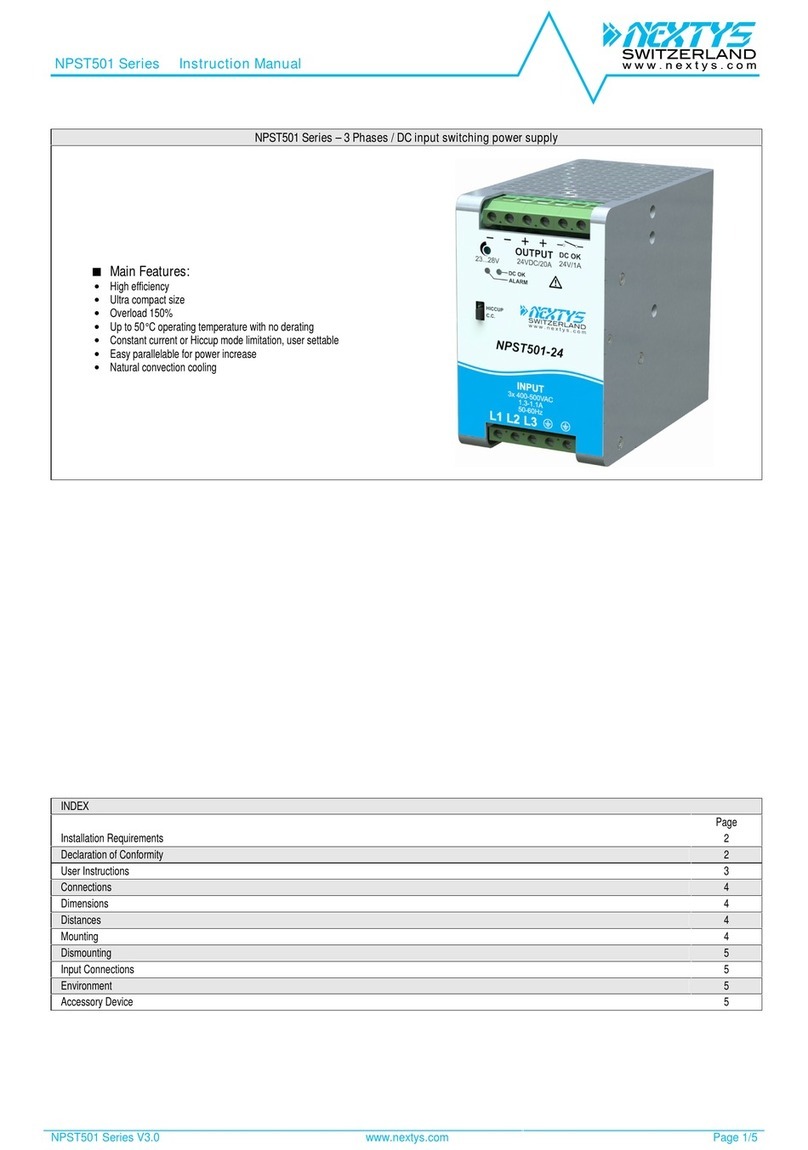
nextys
nextys NPST501 Series instruction manual
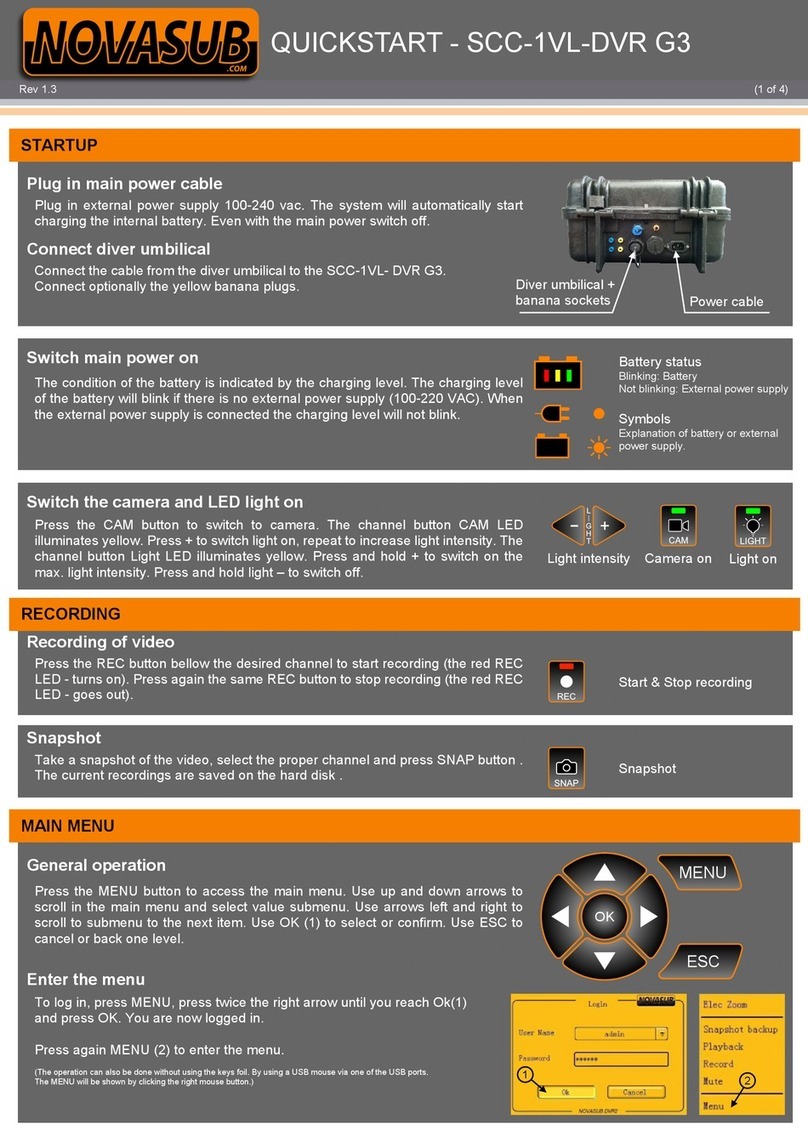
Novasub
Novasub SCC-1VL-DVR G3 quick start guide

Matsusada Precision
Matsusada Precision AMP Series instruction manual
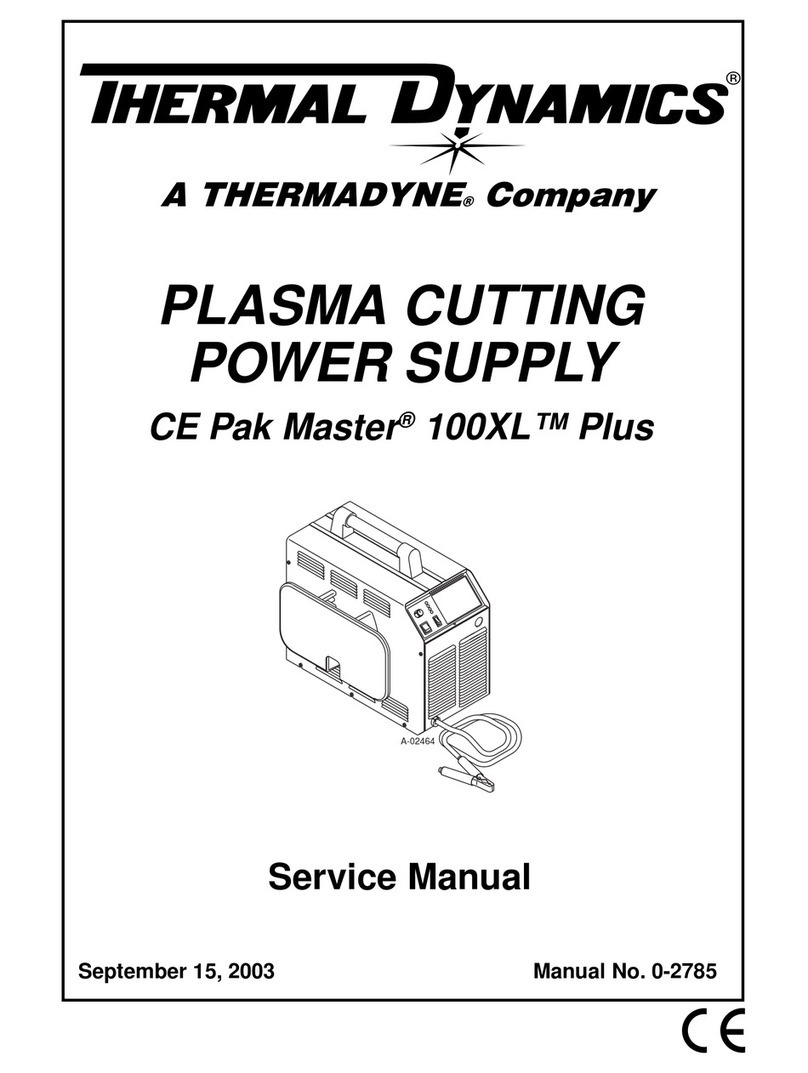
Thermal Dynamics
Thermal Dynamics CE Pak Master 100XL Plus Service manual
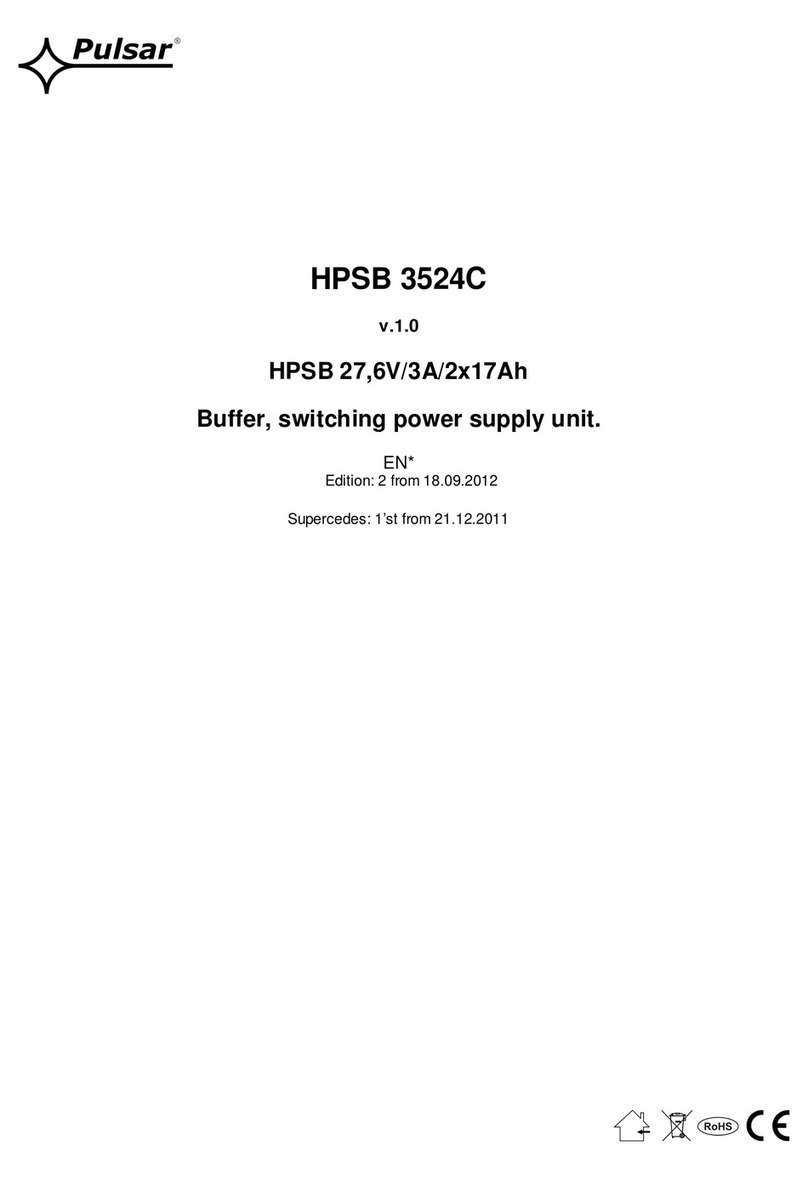
Pulsar
Pulsar HPSB 3524C manual
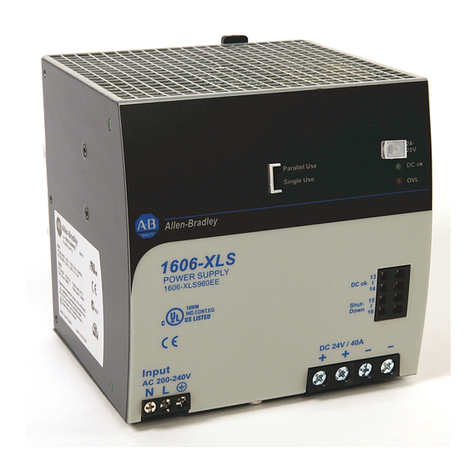
Rockwell Automation
Rockwell Automation 1606-XLS960F Original instructions

